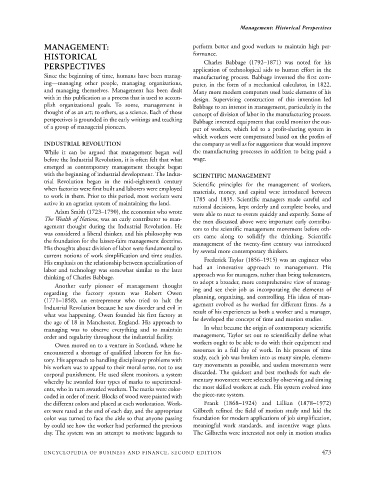Page 496 - Encyclopedia of Business and Finance
P. 496
eobf_M 7/5/06 3:15 PM Page 473
Management: Historical Perspectives
MANAGEMENT: perform better and good workers to maintain high per-
HISTORICAL formance.
Charles Babbage (1792–1871) was noted for his
PERSPECTIVES
application of technological aids to human effort in the
Since the beginning of time, humans have been manag- manufacturing process. Babbage invented the first com-
ing—managing other people, managing organizations, puter, in the form of a mechanical calculator, in 1822.
and managing themselves. Management has been dealt Many more modern computers used basic elements of his
with in this publication as a process that is used to accom- design. Supervising construction of this invention led
plish organizational goals. To some, management is Babbage to an interest in management, particularly in the
thought of as an art; to others, as a science. Each of those concept of division of labor in the manufacturing process.
perspectives is grounded in the early writings and teaching Babbage invented equipment that could monitor the out-
of a group of managerial pioneers.
put of workers, which led to a profit-sharing system in
which workers were compensated based on the profits of
INDUSTRIAL REVOLUTION the company as well as for suggestions that would improve
While it can be argued that management began well the manufacturing processes in addition to being paid a
before the Industrial Revolution, it is often felt that what wage.
emerged as contemporary management thought began
with the beginning of industrial development. The Indus- SCIENTIFIC MANAGEMENT
trial Revolution began in the mid-eighteenth century
Scientific principles for the management of workers,
when factories were first built and laborers were employed materials, money, and capital were introduced between
to work in them. Prior to this period, most workers were
1785 and 1835. Scientific managers made careful and
active in an agrarian system of maintaining the land.
rational decisions, kept orderly and complete books, and
Adam Smith (1723–1790), the economist who wrote were able to react to events quickly and expertly. Some of
The Wealth of Nations, was an early contributor to man- the men discussed above were important early contribu-
agement thought during the Industrial Revolution. He tors to the scientific management movement before oth-
was considered a liberal thinker, and his philosophy was ers came along to solidify the thinking. Scientific
the foundation for the laissez-faire management doctrine. management of the twenty-first century was introduced
His thoughts about division of labor were fundamental to by several more contemporary thinkers.
current notions of work simplification and time studies.
His emphasis on the relationship between specialization of Frederick Taylor (1856–1915) was an engineer who
labor and technology was somewhat similar to the later had an innovative approach to management. His
thinking of Charles Babbage. approach was for managers, rather than being taskmasters,
to adopt a broader, more comprehensive view of manag-
Another early pioneer of management thought
regarding the factory system was Robert Owen ing and see their job as incorporating the elements of
(1771–1858), an entrepreneur who tried to halt the planning, organizing, and controlling. His ideas of man-
Industrial Revolution because he saw disorder and evil in agement evolved as he worked for different firms. As a
what was happening. Owen founded his first factory at result of his experiences as both a worker and a manager,
the age of 18 in Manchester, England. His approach to he developed the concept of time and motion studies.
managing was to observe everything and to maintain In what became the origin of contemporary scientific
order and regularity throughout the industrial facility. management, Taylor set out to scientifically define what
workers ought to be able to do with their equipment and
Owen moved on to a venture in Scotland, where he
encountered a shortage of qualified laborers for his fac- resources in a full day of work. In his process of time
tory. His approach to handling disciplinary problems with study, each job was broken into as many simple, elemen-
tary movements as possible, and useless movements were
his workers was to appeal to their moral sense, not to use
discarded. The quickest and best methods for each ele-
corporal punishment. He used silent monitors, a system
whereby he awarded four types of marks to superintend- mentary movement were selected by observing and timing
ents, who in turn awarded workers. The marks were color- the most skilled workers at each. His system evolved into
coded in order of merit. Blocks of wood were painted with the piece-rate system.
the different colors and placed at each workstation. Work- Frank (1868–1924) and Lillian (1878–1972)
ers were rated at the end of each day, and the appropriate Gilbreth refined the field of motion study and laid the
color was turned to face the aisle so that anyone passing foundation for modern applications of job simplification,
by could see how the worker had performed the previous meaningful work standards, and incentive wage plans.
day. The system was an attempt to motivate laggards to The Gilbreths were interested not only in motion studies
ENCYCLOPEDIA OF BUSINESS AND FINANCE, SECOND EDITION 473

